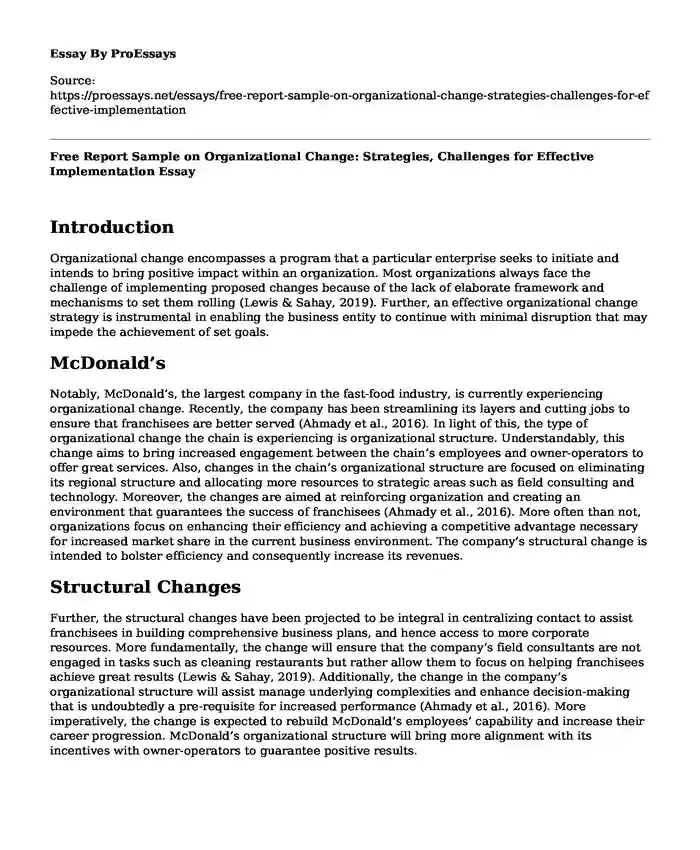Introduction
Organizational change encompasses a program that a particular enterprise seeks to initiate and intends to bring positive impact within an organization. Most organizations always face the challenge of implementing proposed changes because of the lack of elaborate framework and mechanisms to set them rolling (Lewis & Sahay, 2019). Further, an effective organizational change strategy is instrumental in enabling the business entity to continue with minimal disruption that may impede the achievement of set goals.
McDonald’s
Notably, McDonald’s, the largest company in the fast-food industry, is currently experiencing organizational change. Recently, the company has been streamlining its layers and cutting jobs to ensure that franchisees are better served (Ahmady et al., 2016). In light of this, the type of organizational change the chain is experiencing is organizational structure. Understandably, this change aims to bring increased engagement between the chain’s employees and owner-operators to offer great services. Also, changes in the chain’s organizational structure are focused on eliminating its regional structure and allocating more resources to strategic areas such as field consulting and technology. Moreover, the changes are aimed at reinforcing organization and creating an environment that guarantees the success of franchisees (Ahmady et al., 2016). More often than not, organizations focus on enhancing their efficiency and achieving a competitive advantage necessary for increased market share in the current business environment. The company’s structural change is intended to bolster efficiency and consequently increase its revenues.
Structural Changes
Further, the structural changes have been projected to be integral in centralizing contact to assist franchisees in building comprehensive business plans, and hence access to more corporate resources. More fundamentally, the change will ensure that the company’s field consultants are not engaged in tasks such as cleaning restaurants but rather allow them to focus on helping franchisees achieve great results (Lewis & Sahay, 2019). Additionally, the change in the company’s organizational structure will assist manage underlying complexities and enhance decision-making that is undoubtedly a pre-requisite for increased performance (Ahmady et al., 2016). More imperatively, the change is expected to rebuild McDonald’s employees’ capability and increase their career progression. McDonald’s organizational structure will bring more alignment with its incentives with owner-operators to guarantee positive results.
Resistance
It should be noted that organizations experiencing change always face resistance to implement it. Such resistance may impede the achievement of the intended purpose and bring disruption of operations within the organization. Therefore, McDonald’s overcame the resistance by developing strategy and setting goals that outline what is intended to be realized by initiating organizational structure. Additionally, the company leveraged on staff engagement to ensure that they are brought on board as a team (Lewis & Sahay, 2019). The implementation challenges were addressed through the use of effective communication tools to explain to employees the necessity of the change. More significantly, the company offered management support that played a key role in sharing the vision and detailing to owner-operators and managers their role in implementing the change.
Conclusion
In conclusion, the contemporary business environment is experiencing rapid change. To continue operating efficiently and profitably, most businesses are initiating organizational change to ensure that set objectives are aligned with emerging issues to guarantee their achievement. The change in McDonald’s organizational structure is intended to reshape its operations by emphasizing the adoption of technology and improving field consultancy to bring positive results for franchisees. Also, the company's change is expected to bolster decision-making and create a framework that will address complexities that have been posing a threat to their success. More importantly, the company has set an elaborate strategy and improves staff engagement to ensure that any potential resistance to change is overcome.
References
Ahmady, G. A., Mehrpour, M., & Nikooravesh, A. (2016). Organizational structure. Procedia-Social and Behavioral Sciences, 230, 455-462.
https://www.sciencedirect.com/science/article/pii/S1877042816311582
Lewis, L., & Sahay, S. (2019). Organizational change. John Wiley & Sons, Incorporated.
https://onlinelibrary.wiley.com/doi/abs/10.1002/9781119431503
Cite this page
Free Report Sample on Organizational Change: Strategies, Challenges for Effective Implementation. (2023, Oct 15). Retrieved from https://proessays.net/essays/free-report-sample-on-organizational-change-strategies-challenges-for-effective-implementation
If you are the original author of this essay and no longer wish to have it published on the ProEssays website, please click below to request its removal:
- Evaluation Essay on Imperial Hotel
- How Leadership Gets Affected by the Presence of Different Cultures Paper Example
- The Technology Employed by Tres Latin Foods Companies Paper Example
- The Concept of Data Governance Essay Example
- Essay Sample on Strategic Market Analysis
- Paper Example on Business Model: Strategic Approach to Realizing Long-Term Value
- Report Example on Mixed Methods in Nursing: Exploring Chronic Pain Challenges







